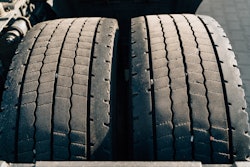A clogged diesel particulate filter (DPF) can quickly impair a truck, dragging down fuel economy and increasing downtime.
TravelCenters of America Vice President of Truck Service Homer Hogg noted that symptoms of a struggling aftertreatment system could include your engine losing power; poor MPG; exhaust smoke; coolant loss with no external leaks; intake leaks; and/or a clogged or extremely dirty air filter.
"The aftertreatment system is designed to alert via the various warning lights as to a detected issue, which most likely will be attributed to increasing exhaust back pressure," added Mark H. Finger, Transervice senior vice president of maintenance & operations. "The warning light is usually the earliest indicator that the aftertreatment system requires attention. Therefore, it is crucial that action be taken in a timely manner to reference the manufacturer’s guidelines for the illuminated warning light and follow the prescribed actions, otherwise, system damage may occur and repair costs can be substantial."
Chris Disantis, senior director of maintenance for Aim NationaLease, said fleets that count on a light or wait for a failure to occur to work on the system are setting themselves up for an expensive repair, and encouraged motor carriers to pay more attention to the warning signs that often surface before a dash light.
"The unit starting to regen more frequently, excessive smoke, an upstream exhaust leak, using coolant with no visual external leak, along with unusual loss of power are other leading indicators that the system is compromised," he said. "Having a preventive maintenance program and cleaning the DPF, replacing the DEF filter and items like this based on the manufacturer’s recommendations can prevent these non-scheduled and high cost events."
Chevron Lubricants Senior Staff Engineer Shawn Whitacre said the plugging of the DPF is a byproduct of it being good at its job and catching particulate matter and anything else that finds its way downstream, like engine oil that’s blown-by the rings.
Much of what's trapped in the DPF (upwards of 90%) is attributable to engine oil additives. Metallic additives in engine oils are beneficial for the oil itself by neutralizing acids and providing wear protection, but Whitacre noted there are formulations available that produce less ash, thereby requiring less maintenance and possibly eliminating a DPF cleaning entirely.
While cleaning the DPF alone may seem logical, Finger said addressing the system components as a whole produces better results in between service intervals.
"Additionally, in order for the system to perform properly, the system must be tight and free of leaks. As such, a torque wrench should be utilized during reassembly of the band clamps, as over tightening can create flange distortion resulting in leaks," he said. "These leaks adversely affect sensor readings which will result in mismanagement of corrections being attempted by the ECM."
Engine manufacturers have preferred, and sometimes required, maintenance procedures and Hogg said it can be confusing for truck owners and operators to determine maintenance intervals and optimal procedures.
"Sometimes a liquid wash is preferred for DPFs versus a bake and blow routine, while replacing the DPF may be the best practice," he said. "A skilled technician using the correct service literature, software and hardware are highly recommended to identify the correct service and maintenance routines for a specific fleet and/or truck."












